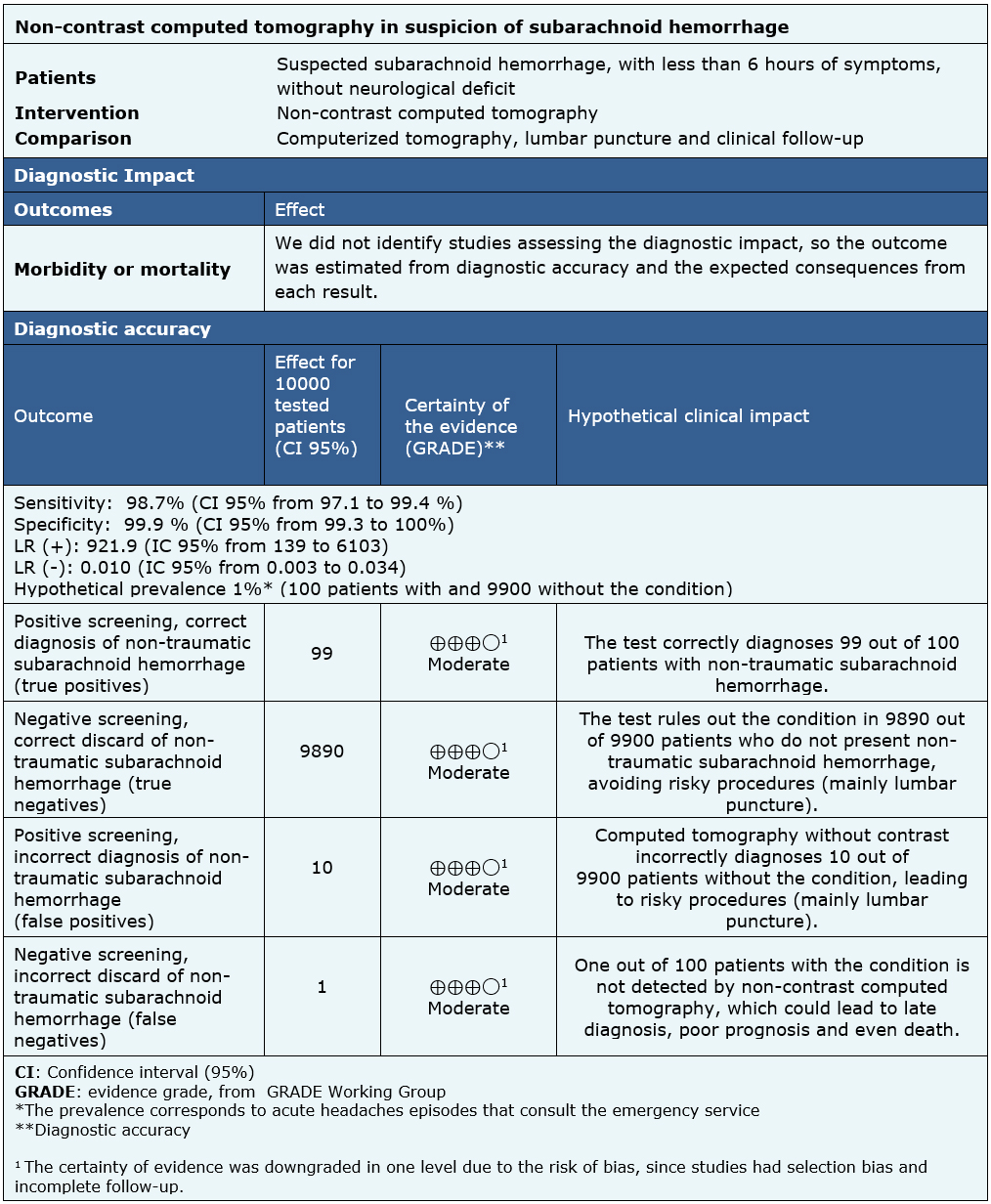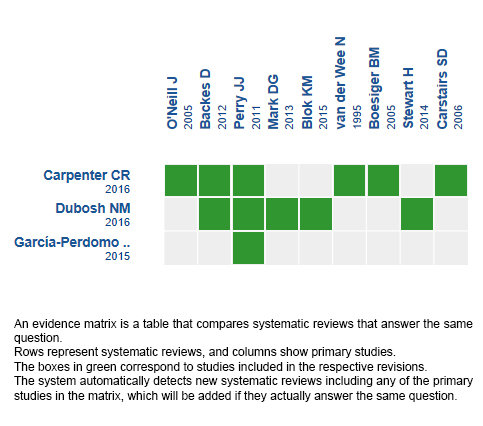Epistemonikos summaries
← vista completaPublished on November 7, 2018 | http://doi.org/10.5867/medwave.2018.07.7321
Non-contrast computed tomography for the diagnosis of non-traumatic subarachnoid hemorrhage
Tomografía computarizada sin contraste para el diagnóstico de hemorragia subaracnoidea no traumática
Abstract
INTRODUCTION Subarachnoid hemorrhage is a neurosurgical emergency that requires timely diagnosis due to its severity and the existence of therapeutic measures that are effective when carried out in time. The most used diagnostic sequence to rule it out is computed tomography without contrast which, if negative, is followed by lumbar puncture. However, it has been suggested that a negative non-contrast computed tomography (without blood) may rule out the diagnosis.
METHODS To answer this question we used Epistemonikos, the largest database of systematic reviews in health, which is maintained by screening multiple information sources, including MEDLINE, EMBASE, Cochrane, among others. We extracted data from the systematic reviews, reanalyzed data of primary studies, conducted a meta-analysis and generated a summary of findings table using the GRADE approach.
RESULTS AND CONCLUSIONS We identified three systematic reviews including nine studies. We concluded the diagnostic accuracy of non-contrast computed tomography is probably very high, but the clinical impact of relying only on this test has not yet been evaluated.
Problem
It is estimated that subarachnoid hemorrhage could be responsible for 1% of headaches in emergency services [1],[2]. Its early diagnosis is very important since it is a neurosurgical emergency with very high morbidity and mortality, and there are therapies that can make an important difference if timely implemented [2]. Although it has a characteristic clinical presentation, the symptoms and signs are not enough to rule it out [1],[2]. The most commonly used sequence is non-contrast computed tomography followed by a lumbar puncture, ruling out the condition with both results negative. However, lumbar puncture is not risk-free (infection, hematoma, and stress for the patient) and its added value is a matter of debate [1],[2].
Methods
To answer the question, we used Epistemonikos, the largest database of systematic reviews in health, which is maintained by screening multiple information sources, including MEDLINE, EMBASE, Cochrane, among others, to identify systematic reviews and their included primary studies. We extracted data from the identified reviews and reanalyzed data from primary studies included in those reviews. With this information, we generated a structured summary denominated FRISBEE (Friendly Summary of Body of Evidence using Epistemonikos) using a pre-established format, which includes key messages, a summary of the body of evidence (presented as an evidence matrix in Epistemonikos), meta-analysis of the total of studies when it is possible, a summary of findings table following the GRADE approach and a section of other considerations for decision-making.
|
Key messages
|
About the body of evidence for this question
|
What is the evidence. |
We found three systematic reviews [1],[2],[3] that included nine primary studies overall [4],[5],[6],[7],[8],[9],[10],[11],[12], none of them a randomized trial. We did not find studies evaluating the clinical impact. We excluded one systematic review [3] because it mixed non-traumatic with peri-mesencephalic subarachnoid hemorrhage, which is considered a different clinical entity. |
|
What types of patients were included* |
All studies included patients older than 11 years, four studies included adults without specifying age [5],[6],[9],[12] and four studies only included patients without neurological deficit [5],[7],[11],[12]. Five studies evaluated patients with less than 6 hours symptom onset [6],[7],[9],[11],[12], one study with less than 12 hours [5] and three studies did not specify it [4],[8],[10]. One study[6] only included patients with negative non-contrast computed tomography for subarachnoid hemorrhage. |
|
What types of interventions were included* |
Five studies used 16-slice or higher computed tomography [6],[7],[9],[11],[12] and the others did not described the type of computed tomography used[4],[5],[8],[10]. As gold standard, six studies used lumbar puncture, imaging, and follow-up[6],[7],[8],[9],[11],[12] and the rest did not reported it [4],[5],[10]. Five studies followed all of their patients [6],[7][8],[9],[11], three studies did not follow up patients [4],[5],[10] and one study had an incomplete follow up (86% of patients)[12]. |
|
What types of outcomes |
The different systematic reviews pooled outcomes as follows: specificity, sensitivity, positive likelihood ratio (LR +), negative likelihood ratio (LR -), true positives, false negatives, false positives and true negatives. |
* The information about primary studies is extracted from the systematic reviews identified, unless otherwise specified.
Summary of findings
Information on the diagnostic accuracy of non-contrast computed tomography for non-traumatic subarachnoid hemorrhage is based on 9 primary studies [5],[6],[7],[8],[9],[10],[11],[12],[13]. All of these measured specificity, sensitivity, LR + and LR- of the non-contrast computed tomography for non-traumatic subarachnoid hemorrhage.
The summary of the findings is as follows:
- It is not clear if non-contrast computed tomography for non-traumatic subarachnoid hemorrhage impacts mortality and morbidity because we did not find studies evaluating this aspect
- Diagnostic accuracy of non-contrast computed tomography for non-traumatic subarachnoid hemorrhage is probably very high.

| Follow the link to access the interactive version of this table (Interactive Summary of Findings – iSoF) |

Other considerations for decision-making
|
To whom this evidence does and does not apply |
|
| About the outcomes included in this summary |
|
| Balance between benefits and risks, and certainty of the evidence |
|
| Resource considerations |
|
| What would patients and their doctors think about this intervention |
|
|
Differences between this summary and other sources |
|
| Could this evidence change in the future? |
|
How we conducted this summary
Using automated and collaborative means, we compiled all the relevant evidence for the question of interest and we present it as a matrix of evidence.

Follow the link to access the interactive version: Accuracy of computed tomography without contrast for the diagnosis of non-traumatic subarachnoid hemorrhage
Notes
The upper portion of the matrix of evidence will display a warning of “new evidence” if new systematic reviews are published after the publication of this summary. Even though the project considers the periodical update of these summaries, users are invited to comment in Medwave or to contact the authors through email if they find new evidence and the summary should be updated earlier.
After creating an account in Epistemonikos, users will be able to save the matrixes and to receive automated notifications any time new evidence potentially relevant for the question appears.
This article is part of the Epistemonikos Evidence Synthesis project. It is elaborated with a pre-established methodology, following rigorous methodological standards and internal peer review process. Each of these articles corresponds to a summary, denominated FRISBEE (Friendly Summary of Body of Evidence using Epistemonikos), whose main objective is to synthesize the body of evidence for a specific question, with a friendly format to clinical professionals. Its main resources are based on the evidence matrix of Epistemonikos and analysis of results using GRADE methodology. Further details of the methods for developing this FRISBEE are described here (http://dx.doi.org/10.5867/medwave.2014.06.5997)
Epistemonikos foundation is a non-for-profit organization aiming to bring information closer to health decision-makers with technology. Its main development is Epistemonikos database (www.epistemonikos.org).
Potential conflicts of interest
The authors do not have relevant interests to declare.

